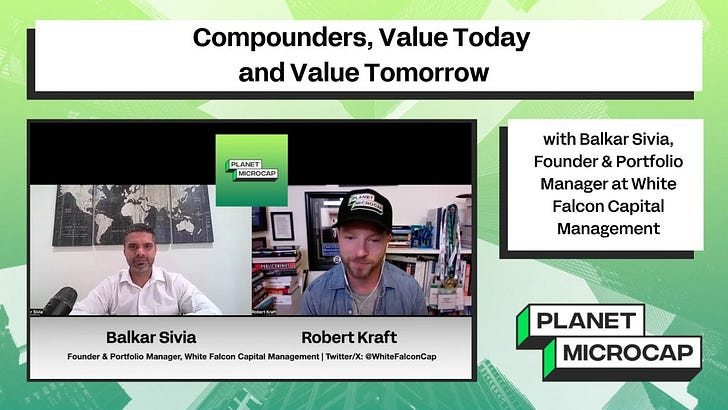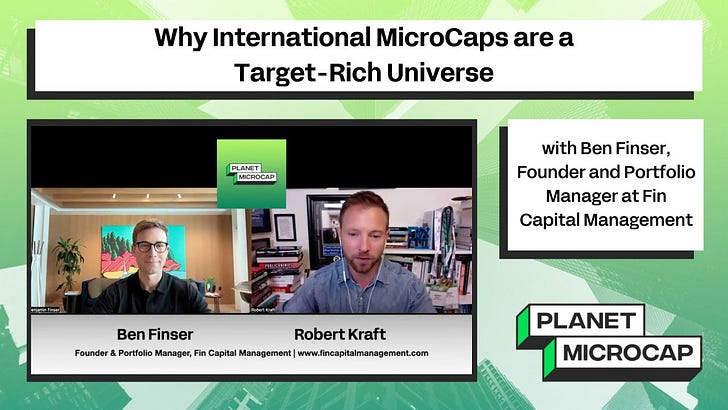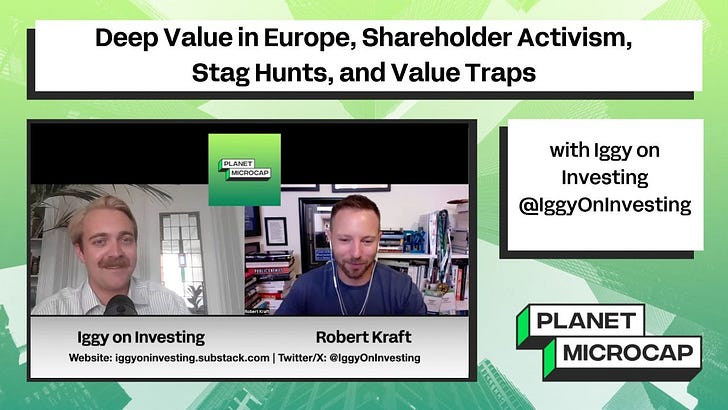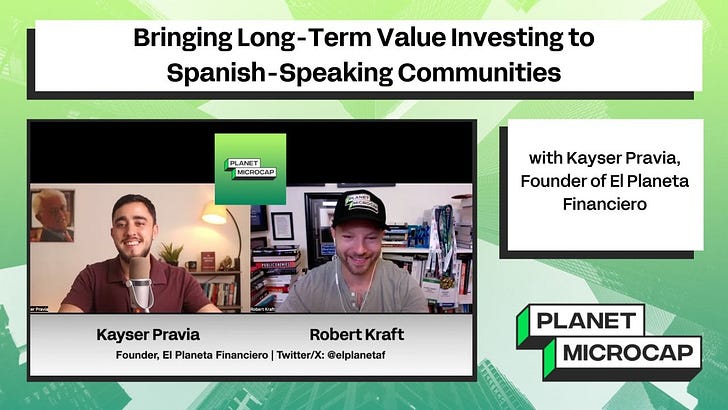My guest on the show today is Asif Suria, founder of Inside Arbitrage and co-host of the Special Situations Report podcast. In this episode, Asif shares his evolution from traditional value investing to a diversified, event-driven strategy that includes merger arbitrage, spin-offs, buybacks, insider activity, and more.
We dive into his “three-legged stool” process — combining event triggers, a 14-factor quant model, and deep qualitative research — and how it’s helped him navigate both opportunities and challenges in special situations. Asif also walks through real-world examples, highlighting lessons learned from his biggest wins and most humbling setbacks.
For more information about Inside Arbitrage and the Special Situations Report Podcast, please visit:
https://www.insidearbitrage.com/
You can Follow Asif Suria on Twitter/X @AsifSuria: https://x.com/asifsuria
Watch on YouTube:
Summary:
1. The Genesis of Event-Driven Investing
Suria's passion for investing began in 2001, a challenging period following the dot-com bubble burst. His early experiences with the dot-com bear market and the 2008–2009 Great Recession bear market (where “indexes decline[d] as much as 50% or more”) led him to seek “a less painful way of approaching investing.” This quest resulted in his pivot to event-driven strategies, starting with merger arbitrage.
Initial Philosophy: Began as a “value investor,” influenced by figures like Ben Graham, Phil Fisher, and Peter Lynch.
Shift to Event-Driven: The desire for a less painful investment approach, particularly after experiencing significant market downturns, led to exploring event-driven strategies.
Merger Arbitrage as a Starting Point: “The first event-driven strategy that I got interested in was merger arbitrage,” which involves profiting from the spread between a target company's current market price and its acquisition price.
2. Identifying and Exploiting Market Inefficiencies
Suria emphasizes that while broad markets are “quite efficient,” “there are pockets of inefficiencies.” Event-driven strategies are designed to capitalize on these less efficient areas.
Pockets of Inefficiency: Examples include “GameStop, the meme stock mania,” and “micro caps,” where “there just isn't a lot of institutional money that can play in that arena.”
Event-Driven Strategies and Inefficiency: “Event-driven strategies potentially gave you an opportunity to participate in a less efficient market.” This inefficiency arises because events like spin-offs create situations where the market needs time to “fully understand what's happening here.”
Spin-offs as a Prime Example: Spin-offs create inefficiency due to a lack of historical data for the new entity and “natural inefficiency built in where if you own a company... you probably don't want the energy company and you're going to sell it off or forget all about it in your portfolio and that creates a certain amount of selling pressure that Greenblatt discussed in his book You Can Be a Stock Market Genius.”
3. The “Toolbox” of Event-Driven Strategies
To navigate varying market conditions and capitalize on different opportunities, Suria advocates for a diverse “toolbox” of event-driven strategies rather than relying on a single approach.
Multiple Strategies: “Certain strategies come in favor and then go out of favor... I wanted to have a toolbox with multiple strategies that I could deploy at different points in times.”
Core Strategies Tracked by Inside Arbitrage:
Merger Arbitrage (M&A): Company acquisitions. Faced challenges in recent years due to “very irrational antitrust.”
Spin-offs: A company separating a division into an independent entity. Currently a “great area that continue[s] to work.”
Management Changes: Appointments or sudden departures of key executives. “Pretty big area that for some reason retail investors and often professionals don't pay a lot of attention to.”
SPACs (Special Purpose Acquisition Companies): Can offer both long and short opportunities.
Buybacks: Companies repurchasing their own stock, signaling management's belief that “the stock is underpriced.”
Insider Transactions: While not traditionally “event-driven,” they are “overlaid against other events” (e.g., a “double dipper screen” when combined with buybacks).
Strategies Not Tracked: Bankruptcies are avoided due to their “complexity and the need for legal talent to be able to analyze that.”
4. The Investment Process: A Three-Legged Stool
Suria outlines a systematic three-step process for evaluating investment opportunities:
Event (Idea Generation): The initial trigger.
Quantitative Model: A “14 factor model” classifies every US company and assigns a score. A score of “70 or above” typically prompts a closer look, though this is not a rigid rule. The model helps “quickly run through ideas.”
Qualitative Work: In-depth analysis beyond the quantitative score. “There might be situations where the qualitative work might point to something interesting even though the quantitative score might not be quite as high as we would like.”
Example – Management Changes (GE vs. Intel):
Larry Culp at GE: Culp, from Danaher (known for its “Danaher business system” combining Kaizen and Six Sigma), was appointed CEO of GE, a “completely broken company.” Suria observed Culp's “playbook of starting to do a bunch of spin-offs” to streamline GE into a “lean aircraft engines company with high margins and high revenue growth and essentially a pristine balance sheet.” An “insider transaction” by Culp further piqued interest. Despite an initial “decline 40%” in stock price, GE subsequently saw significant gains.
Pat Gelsinger at Intel: While Gelsinger was a respected engineer, Intel's “very generous” pay package for him was a red flag. The attempted spin-off of Mobileye did not yield the desired results, leading Suria to “pass on Intel.”
5. Portfolio Construction and Risk Management
Suria emphasizes the importance of portfolio construction, viewing different event-driven strategies as serving distinct roles within a diversified portfolio.
Holding Period: Prefers to hold positions for “at least three years,” unless it's a liquidation scenario.
Merger Arbitrage as Fixed Income Alternative: For Suria, merger arbitrage served as “an alternative to fixed income investing” when interest rates were low, offering higher annualized returns than traditional bonds.
Allocation: Typically “60 to 70% stocks, 30% on the merge arbitrage side.” However, this allocation is flexible based on market conditions, with less allocated to merger arbitrage during difficult periods.
6. Case Studies: Successes and Lessons Learned
Biohaven (Success Story): A “completely fascinating situation” where “three different event-driven strategies came together.”
Merger Arbitrage: Acquisition by Pfizer for $148.50/share, offering a modest spread.
Spin-off: Pfizer was only interested in Biohaven's migraines drugs, spinning off the remaining pipeline with significant cash funding ($350–400 million). This added substantial value per share.
Insider Transaction: An insider bought stock just before the deal closed for a mere 50-cent spread, indicating strong interest in the spin-off, not just the merger arbitrage. The new Biohaven stock soared from $7 to $40.
Key Takeaway: “That's the stuff that really excites us when we start seeing different things come together to create a unique signal.”
Capri & Tapestry (Failure Example – Merger Arbitrage): A deal that “did not work out.” Suria highlights the irrationality of regulators blocking this merger, especially when “even Bill Gross was in it,” and it was widely expected to close. This underscored the unpredictability of regulatory intervention.
Lionsgate Entertainment (Failure Example – Spin-off/Activism): Lionsgate Studios was spun out of Lionsgate Entertainment. The situation “hasn't quite worked out” due to:
Overpayment for Acquisition: Lionsgate “acquired Stars for $4 billion just as everybody was cutting the cord.”
Delayed Spin-off: The spin-off “took a really long time to happen.”
Activist Involvement: Despite an activist (Mark Racheski) on the board, the situation remains unresolved, with a second activist (Steven Mnuchin) now involved.
Pinstripes (Key Learning – SPACs and Credit Risk): This company, involved in entertainment (bowling, dining, corporate events), went public via a SPAC.
Red Flags Missed: Suria acknowledged that going public via a SPAC “should have been my first red flag.”
Overlooked Credit Risk: The significant debt provided by Oak Tree to the company was a critical oversight. If Pinstripes couldn't execute its growth plan, Oak Tree could “essentially end up owning the company through the bankruptcy process.”
Key Learning: “It taught me to look at more things on the credit side of things and to be even more aware of companies that go public through a spack route.”
7. Event-Driven Strategies in Micro Caps
While the general principles apply, specific nuances are important for micro caps.
Insider Transactions Nuance:
Market Often Right: “More likely than not, the market is right, the insider is wrong.” Insiders may be biased or anchored to old prices.
Signaling: Sometimes insider buying is simply “buy to signal to you and me saying, ‘Hey, maybe you should look at the stock. I'm buying a bunch of stock and nothing's wrong here.’”
Cluster Buying Across a Sector: The most significant signal for insiders is “not cluster buying just within a company but cluster buying across a sector.”
Examples: Energy companies in 2020 when “crude oil went negative,” and regional banks during the “regional banking crisis” of Silicon Valley Bank's failure.
Significance: This “combination... is something we pay close attention to and then the factor models go out the window.”
8. Future Outlook: Biotech as a Potential Hotbed
Suria identifies the biotech sector, particularly “zombie biotech companies,” as a potential area for increased event-driven activity.
“Nuclear Winter” in Biotech: The sector has experienced a “nuclear winter,” especially for companies with “a lot of cash on the balance sheet” but failed primary products.
Activist Pressure: Investors are “trying to push management teams to do the right thing and return the capital to the shareholders.”
Bottom Fishing: New entities like Concentra Biosciences and Zuma Royalty are “out there fishing at the bottom levels of the biotech thing,” acquiring cash-rich biotechs.
Pharma Company Acquisitions: If “pharma companies start buying on the top end of the things,” combined with insider buying, “you might start seeing the cycle turn on the biotech side of things.”
Key Risk: “The Trump administration really pushing down on prices for former companies.”
Planet MicroCap Podcast is on YouTube! All archived episodes and each new episode will be posted on the Planet MicroCap YouTube channel. I’ve provided the link in the description if you’d like to subscribe. You’ll also get the chance to watch all our Video Interviews with management teams, educational panels from the conference, as well as expert commentary from some familiar guests on the podcast.
Subscribe here: http://bit.ly/1Q5Yfym
Click here to rate and review the Planet MicroCap Podcast
The Planet MicroCap Podcast is brought to you by SNN Incorporated, The Official MicroCap News Source, and the Planet MicroCap Review Magazine, the leading magazine in the MicroCap market.
You can Follow the Planet MicroCap Podcast on Twitter @BobbyKKraft










